Related Research Articles

A desk or bureau is a piece of furniture with a flat table-style work surface used in a school, office, home or the like for academic, professional or domestic activities such as reading, writing, or using equipment such as a computer. Desks often have one or more drawers, compartments, or pigeonholes to store items such as office supplies and papers. Desks are usually made of wood or metal, although materials such as glass are sometimes seen.
A secretary desk or escritoire is made of a base of wide drawers topped by a desk with a hinged desktop surface, which is in turn topped by a bookcase usually closed with a pair of doors, often made of glass. The whole is usually a single, tall and heavy piece of furniture.
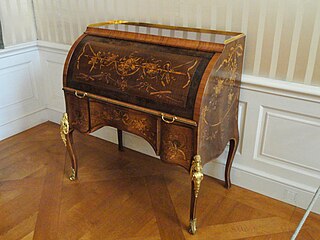
The cylinder desk is a desk that resembles a Bureau Mazarin or a writing table equipped with small stacked shelves in front of the user's main work surface, and a revolving cylinder part that comes down to hide and lock up the working papers when the desk is not in use.

The fall front desk can be considered the cousin of the secretary desk. Both have a main working surface or desktop which does double duty as a cover to seal up papers and other items located in small shelves or small drawers placed one on top of the other in front of the user. Thus, all working papers, documents and other items have to be stored before the desk is closed.
The Wooton desk is a variation of the fall front desk.
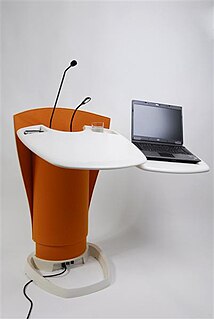
The lectern desk exists in two distinct forms, antique and modern.
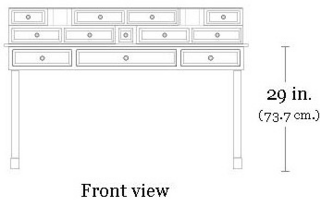
A bureau à gradin is an antique desk form resembling a writing table with, in addition, one or several tiers of small drawers and pigeonholes built on part of the desktop surface. Usually the drawers and pigeonholes directly face the user, but they can also surround three sides of the desk, as is the case for the Carlton house desk form. A small, portable version is a bonheur du jour.
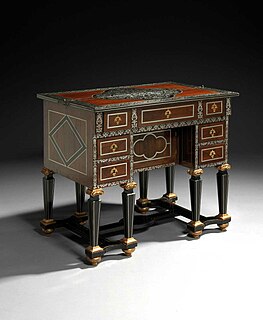
The bureau Mazarin is a 17th-century desk form named more or less in memory of Cardinal Mazarin, who was the Chief minister of France from 1642 to 1661. It is the earliest predecessor of the pedestal desk and differs from it by having only two tiers of drawers or three tiers of rather small drawers under the desktop surface, followed by eight legs supporting the whole. Also, the bureau Mazarin has cross braces between the legs, forming two Xs or two Hs on each side.
The fire screen desk is a very small antique desk form meant to be placed in front of a fireplace to keep a user's feet warm while he or she is stationary while writing. This kind of desk was very popular in prosperous homes in Europe during the 18th century and slowly disappeared during the 19th, with the gradual introduction of stoves and central heating.

Jean-Henri Riesener was a famous German ébéniste (cabinetmaker), working in Paris, whose work exemplified the early neoclassical "Louis XVI style".
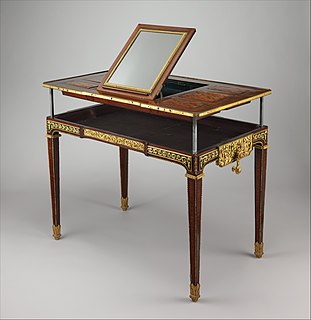
A Liseuse desk is a medium-sized writing table with a small hinged panel in the middle which can spring up by the aid of a mechanism or be propped up at a desired angle to facilitate reading, or writing on its slanted surface. Many have lateral panels which swing out on both sides to give a larger desk surface.

A Games table desk is an antique desk form which combines the type of surface required for writing with a surface etched or veneered in the pattern of a given board game. It also provides sufficient storage space for writing implements and a separate space for storing game accessories such as counters. It is often called a "games table" or game table, which leads to confusion with pieces of furniture which are built specifically for gaming only, with no intention or provision for use as a desk.

Rocaille was a French style of exuberant decoration, with an abundance of curves, counter-curves, undulations and elements modeled on nature, that appeared in furniture and interior decoration during the early reign of Louis XV of France. It was a reaction against the heaviness and formality of the Style Louis XIV. It began in about 1710, reached its peak in the 1730s, and came to an end in the late 1750s, replaced by Neoclassicism. It was the beginning of the French Baroque movement in furniture and design, and also marked the beginning of the Rococo movement, which spread to Italy, Bavaria and Austria by the mid-18th century.

Martin Carlin was a Parisian ébéniste (cabinet-maker), born at Freiburg, who was received as Master Ébéniste at Paris on 30 July 1766. Renowned for his "graceful furniture mounted with Sèvres porcelain", Carlin fed into the luxury market of eighteenth-century decorative arts, where porcelain-fitted furniture was considered among "the most exquisite furnishings" within the transitional and neoclassical styles. Carlin's furniture was popular amongst the main great dealers, including Poirier, Daguerre, and Darnault, who sold his furniture to Marie Antoinette and many amongst the social elite class. He died on 6 March 1785.
Lignereux is a French company, founded in 1787, which produces objets d'art. Established in Paris and London, Lignereux plays a major role in decorative arts. Lignereux makes objects which are intended for art collectors. In 2015 Lignereux began to produce new objects, decorated by contemporary artists and craftspeople.

The furniture of the Louis XV period (1715-1774) is characterized by curved forms, lightness, comfort and asymmetry; it replaced the more formal, boxlike and massive furniture of the Style Louis XIV. It employed marquetry, using inlays of exotic woods of different colors, as well as ivory and mother of pearl.

Louis XIV furniture was massive and lavishly covered with sculpture and ornament of gilded bronze in the earlier part of the personal rule of King Louis XIV of France (1660–1690). After about 1690, thanks in large part to the furniture designer André Charles Boulle, a more original and delicate style appeared, sometimes known as Boulle Work. It was based on the use of marquetry, the inlay of piece of ebony and other rare woods, a technique first used in Florence in the 15th century, which was refined and developed by Boulle and others working for the King. Furniture was inlaid with thin plaques of ebony, copper, mother of pearl, and exotic woods of different colors in elaborate designs.

Louis XVI furniture is characterized by elegance and neoclassicism, a return to ancient Greek and Roman models. Much of it was designed and made for Queen Marie Antoinette for the new apartments she created in the Palace of Versailles, Palace of Fontainebleau, the Tuileries Palace, and other royal residences. The finest craftsmen of the time, including Jean-Henri Riesener, Georges Jacob, Martin Carlin, and Jean-François Leleu, were engaged to design and make her furniture.

Jean-Baptiste-Claude Séne (1747-1803) was a French furniture maker in the 18th century, primarily during the reign of Louis XVI. He came from a noted family of menuisiers, or furniture craftsmen. cabinet makers. His grandfather Jean established a workshop, which was inherited by his father Claude I (1724-1792), who earned the title of a master craftsman in 1743, and made chairs and armchairs for Louis XV. Jean-Baptiste-CLaude became a master in 1769. His younger brother, Claude II, also became a master in 1769, and both made chairs for Louis XVI.
References
- ↑ Lovreglio, Aurelia; Lovreglio, Anne (2006). Dictionnaire des mobiliers et des objets d'art du Moyen Age au XXI siècle. Le Robert. p. 56.